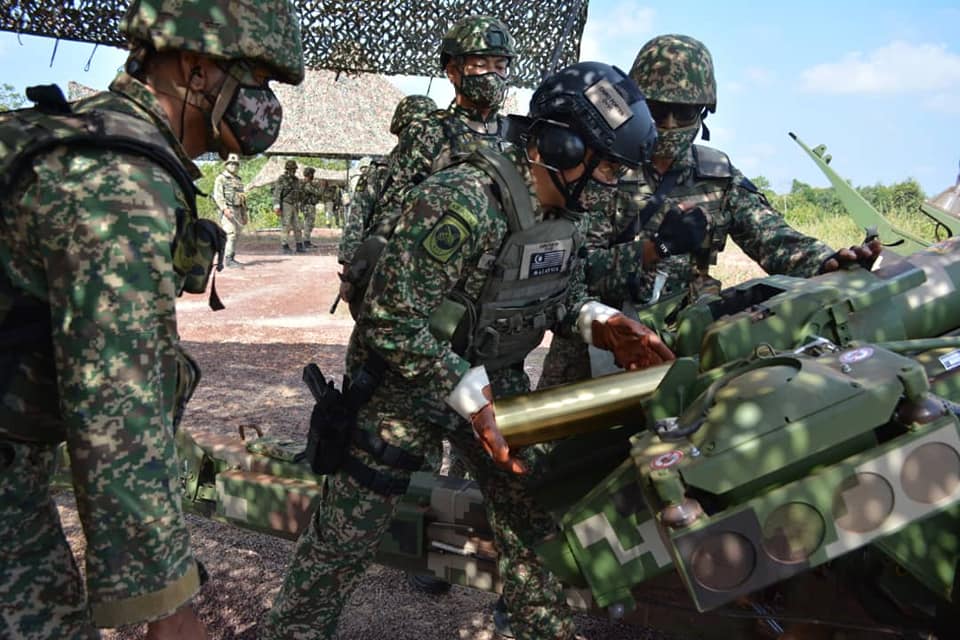
SHAH ALAM: Nexter LG1 howitzers in the wild. The Army 1st Royal Artillery Regiment (Para) has undertaken a firing exercise involving the newly delivered Nexter LG1 Mk 3 105mm howitzers at the Gemas range, from Feb 22 to 25. This was the first time a firing exercise involving the newly delivered the Nexter 105mm howitzers were publicly shown since the guns were delivered last year.
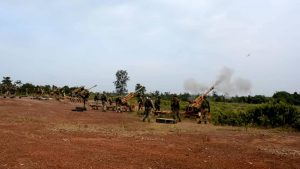
According to the Defence Minister the Army has taken delivery 17 out of 18 105mm guns last year with the last one expected this year.
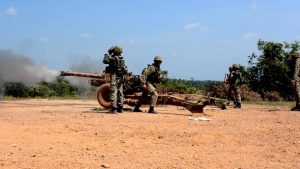
From BTDM
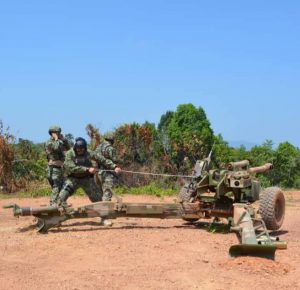
EKSESAIS SHELLDRAKE BUKTI KESIAPSIAGAAN 1 RAD PARA
NEGERI SEMBILAN: Panglima 10 Briged (Para), Brig Jen Khairul Azmizal Ahmad Natal dan Pengarah Artileri, Brig Jen Dato’ Dr Hj Ibrahim Yasir melakukan lawatan ke Eksesais Shelldrake Para Siri 1/2021 yang dilaksanakan oleh Rejimen Pertama Artileri Diraja (1 RAD) (Para) bermula pada 22 hingga 25 Feb 2021.
Lawatan ini bertujuan untuk melihat tahap kesiapsiagaan dan kompetensi pasukan dari aspek peranan serta tugas dan pada masa yang sama melihat persiapan pasukan dalam menghadapi latihan Briged iaitu Eksesais Para Predator dan Eksesais Gerak Pantas yang bakal berlangsung pertengahan tahun 2021.
Eksesais ini bertujuan untuk menilai tahap kompentensi krew mengendalikan persenjataan Meriam 105mm LG1 MK III dan sub sistem serta memastikan kebolehgunaan persenjataan ini.
Terdahulu, 1 RAD (Para) telah melaksanakan tiga siri kursus penyesuaian bagi persenjataan yang merangkumi pengendalian meriam serta sub sistem sebelum melaksanakan latihan tembakan.
Sejurus Panglima dan Pengarah Artileri mendengar taklimat eksesais, program diteruskan dengan latihan tembakan tidak langsung di Tapak Meriam G26, tembakan langsung di Pos Pemerhati Bukit Kidney dan pertunjukan Tindak Cepat.
Panglima 10 Bgd (Para) turut melaksanakan kawad tindakan dan menembak meriam.
Panglima 10 Bgd (Para) menekankan kepada setiap krew untuk meningkatkan kompetensi diri dalam melaksanakan peranan dan tugas 1 RAD (Para) bagi mendokong aturgerak 10 Bgd (Para).
– 10 Briged (Para)
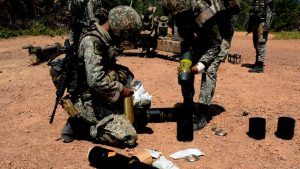
From the above post, we know that two more exercises involving the same regiment and likely the rest of the 10th Para Brigade is expected this year. Hopefully I will be able to cover one of the exercises once the pandemic becomes under control.
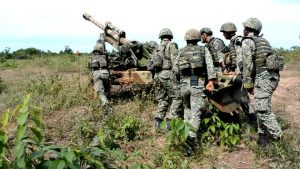
— Malaysian Defence If you like this post, buy me an espresso. Paypal Payment


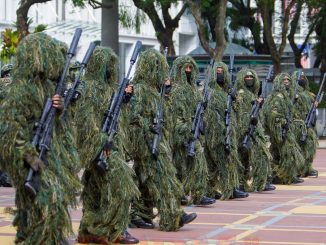
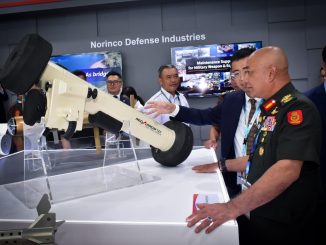
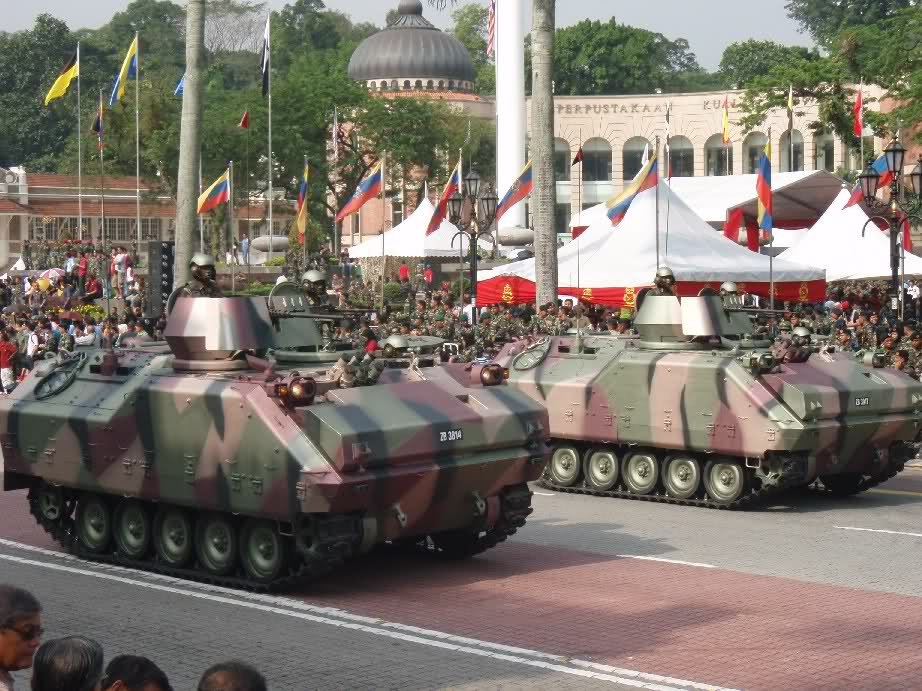
Hopefuly soon we can see these guns “flying” with TUDM Caracals.
With only 12 Cougars [2 in Sabah] in service; slinging even a battery with crews and ammo will be a big challenge.
‘Hopefully’ we’ll see more of them sooner rather than later to replace more Model 56’s which are close to 50 odd years old. I also hope we get more 155mms as 105mms lack therange for counter battery, interdiction and other things.
We can make do w/o towed 155s rather I would prefer a composition of towed/air portable 105s and SPG 155s.
Nimitz – “Hopefuly soon we can see these guns “flying” with TUDM Caracals”
It remains to be seen if we intend pallet dropping the LG-1s.
Like airlifting things it’s a useful capability/skill set to have but it’s totally dependent on having the needed airlift when needed.
Sounds grand on paper or in a brochure but the reality id it will several sorties just to lift a battery (never mind a regiment) of guns, crews and ammo.
There is also the question if whether operational circumstances call for airlifting or pallet dropping things. Maintaining the capability is also resource intensive.
@nimitz
“flying” with TUDM Caracals.”
By right it should be flying with TDM chopper division. High time for TUDM to divest this role completely and hand it to TDM. TDM too must push to get S-70is as soon as possible by omitting any miltech goldplating specs.
Marhalim, I noticed only a few of the men have FAST helmets. Are they still being slowly phased in?
Reply
It depends on which unit really, the regular paras are mostly using the FAST helmets. The one with the FAST helmet is the Para Brigadier. Don’t think the artillery boys are hard up for the helmets as they got to play around with million ringgit whoop ass
@joe
I pointed out Caracal knowing TUDM had perform underslung for Model 56 in
recent exercises plus PUTD lost its arty underslung capability.
The photos here “missed” the gun towers. Are they the GKM-1?
Reply
Not sure really about the gun towers for the LG1s we will have to wait for picture or verbal confirmation
@nimitz
Out of desperation more than what they liked. But with PUTD setup, TUDM had wanted to letgo hauling the Army and vice versa TDM prefers to have their own chopper fleet. Things didn’t work out as planned with refurbed old choppers so its high time TDM given priority to get new medium lifters ASAP. IMHO S-70i is the best option.
“TDM given priority to get new medium lifters ASAP.”
Hopefully TDM register that under Mobility III or IV or watever name and ram it in FY2022 (and beyond)
Nimitz – “Hopefully TDM register that”
Registering it is the easy part. The not so easy part is getting it approved; followed by funding allocation. Even then; it remains to be seen how many will be funded.
Where we are now if the result of years of procrastination and reluctance to make the needed investments – a long list of things which should have been retired long ago; things awaiting replacement and things about to time expire.
Never mind stuff like air assault and air lifting arty (we never had the numbers to go beyond lifting token amounts of men/material and to sustain it); what we have is the bare minimum for peacetime requirements. The fact that the RMAF only has 12 rotary utility birds and the army has to retire what it received after such a short period; is telling of the state of things and how seriously we view defence.
The Blackhawks may not be the most suitable heli for lifting 105mm howitzers. It depends on the weight. The blackhawks were unable to lift their own 105mm guns for instance. I have not seen blackhawks lifting guns.
Thats why the US is looking at both new BELL Valour n the new Sikorsky Boeing hybrid heli where both can lift guns to replace the blackhawks
Lee,
– The only unit in the U.S. army with towed 105mm guns is the Airborne and a couple of other units.
– For the U.S. army the primary means of lifting heavy stuff is the Chinook.
Whoever that tried to promoting the Sakti 105mm (copy of BAE L118) back in 1997 must be mad now.
Reply
Not really
@Lee Yoke Meng
Picture speaks better
https://commons.wikimedia.org/wiki/File:M119_slingloaded_by_UH-60.jpg
And the LG1 is even lighter than US M119. Depending on the scenarios envisioned by TDM, they might still have a need for chopper borne arty.
Reply
Well it depends on what will happened next in the procurement tunnel. It must be said that lifting a battery of guns or a whole regiment needs more helicopters than what is envisioned currently. What so hard about lifting four guns then? You need to have eight helicopters realistically to make it work really unless it’s just a demonstration.
Alex – “promoting the Sakti 105mm (copy of BAE L118)
It wasn’t a “copy”. The Royal Ordnance Light Gun was to have been assembled at the Naval Dockyard.
Alex – “ must be mad now”
It was a good idea. More range and versatility compared to the Model 56.
Marhalim – “need to have eight helicopters realistically to make it work really unless it’s just a demonstration”
Yes. Assuming it’s 4 guns – 4 to lift the guns and another 4 to lift the crews and ammo. On top of that if the guns have to be resupplied with ammo; it’s more sorties. The guns also might have to be lifted out later; yet more sorties.
During the Falklands; just to lift
a battery of 6 guns, crew and 500 rounds of ammo per gun took 85 Sea King sorties. One might say we won’t need 500 rounds per gun which I would counter by saying we can’t assume we’ll
also be in low intensity situations.
During the 2nd Emergency we did lift 105mms to forward operating bases which were hard to access but it was a small number of guns and ammo and helis were available. It also helped that it wasn’t very time sensitive.
Air mobility is very resource intensive but is only doable if one has the needed number of helis which are operational and available for the tasking. It is a useful capability to have though (assuming one actually has the operational need) and it does look impressive when a gun is mentioned in a sales catalogue as being capable of being air lifted.
@Marhalim
“more helicopters than what is envisioned currently”
That’s one thing, back when airlifting arty was in vogue, we had 30-40 units to go around. Realistically, the medium choppers should be bought to cover these numbers retired. Operationally today there is lesser need to airlift into theater, now that more areas are being urbanised and opened, we also have other options today like the G5s, Astros and air to ground support that were not available to our guys during the Emergency.
Reply
They got ATG support during the emergency in 70s and 80s with the Tebuan and the gun equipped Allos. When the British and Australian were around they used Lancasters. But I think we realised from the Vietnam war ATG isn’t that important in the larger scheme of things. That’s why we started sending out small teams to seek out the bandits in the late 70s and early 80s which was more successful, though, most of it remained a secret
Marhalim – “But I think we realised from the Vietnam war ATG isn’t that important in the larger scheme of things”
A big difference was the nature of the threat: we faced lightly equipped foes who were hard to locate and moved around in small numbers. Most of our air to ground efforts were in interdiction rather than close support which was a regular thing in Vietnam.
In Vietnam; despite many equating it with being a counter insurgency war; the Yanks faced the NVA which were organised and deployed in regimental and divisional size. Even the VC at times operated at medium to large unit level. On hundreds of occasions it was close air support which saved the day.
On paper we have a mix – 105mm guns for close direct support, 155mm guns for interdiction, counter battery and other things and MLRSs for longer range targets at an operational level (until we get a precision round ASTROS is a saturation weapon; we didn’t sign the Oslo treaty so we still have sub munitions/clusters.
That’s on paper; in reality we don’t have mass (small number of guns relative to the number of combat units) and no ISR assets to acquire and observe targets. Whether we have the right organisation and needed doctrine is also the question.
Reply
Yes we have enough of everything but not enough of anything
@Marhalim
“They got ATG support during the emergency”
Rudimentary, at best. And as you said, not really that effective when going against scattered insurgents inside thick forested areas.
“When the British and Australian were around they used Lancasters.”
To be precise, it was Lincolns and not Lancasters.
AM – “To be precise, it was Lincolns and not Lancasters.”
And like the Spitfiitres and other former WW2 assets were used ionly in the very early stages of the Emergency. At the Emergency progressed the Brits hardly employed heavy bombing/firepower for the reason that there weren’t large targets.
The company that supposed to assemble the sakti gun was PSC-ND so eh, in hindsight the army might dodged a bullet there
Not necessarily so. The guns would have been supplied in kit firm with the needed tools, manuals and Royal Ordnance people. On top of that a number of Naval Dockyard people would have undergone training in Britain.
A fairly straightforward exercise; compared to building a ship from the keel up and fitting it out. Why the Sakti programme never progressed beyond the planning stage was never announced.
Reply
My best guess is that PSC ND saw that they will have to work with the Bae Systems for the project. This is contrast with their deal with the Kedah class which allowed them full control of the project. Of course it may well be the Army didn’t want funds diverted away from the MLRS project
@Marhalim
“didn’t want funds diverted away from the MLRS”
TDM got the G5s about same time as MLRS. I’m guessing back then they got option either to go big or go home, and rather than sticking with 105s they went for the biggest Whoop A.. combo of 155s and MLRS.
But still..additional orders for lg1 still needed right ? to partly replace oto melara’s even not on 1 on 1 basis..numbers game, i expected para arty needed at least 60 to 72 lg1 to supplement them and hopefully arty reg
will finally get their long desired 155mm sph..
Reply
The Para regiment already got their requirements, 16 guns.
@Firdaus
The conundrum is there is no enough money to buy new and they spurned the chance to get used. So what did they end up with? Nothing. Same goes with TUDM.
Reply
How is it the same with TUDM? Its not like they been offered with EDA aircraft.
I see 18 for 3 batteries..so additional order of lg1 (if any) is for arty reg or is it true they prefer to raise more 155mm one? Towed or sph
Reply
Nope, 16. So far I have not heard of any deal for more LG1s or whether the 155mm will be in ascendant. If it does it may well be a mix of towed and SPH
Firdaus – I see 18 for 3 batteries”
A small number will be allocated for a training battery and it depends on how many guns are in a battery.
Marhalim,
My guess is that the Sakti programme was put forward by the Naval Dockyard and that the army wasn’t interested in replacing the Model 56s in that period (1997/1998): when (as you said) the focus was on MLRSs.
Reply
Its also telling that both the 155 and MLRS came from South Africa and Brazil.
That’s because the army had plenty of oto melara (close to 200 pieces afaik) and only a handful of 155mm arty (fh-70) and none of MLRS so kinda understandable why the army wanted something else back then.
Still, LG1 being developed as more towards lightweight arty (because africa) makes it about as fragile as oto melara which is too fragile for sustained barrages. So if the army brought them wholesale as replacement for oto melara we will pretty much ended up with the same problem all over again. Hence, despite the army looked over the L118/M119 artillery before,it would be a much better solution compared to LG1
@Marhalim
“How is it the same with TUDM?”
We got a chance to get those Kuwaiti Hornets that will seriously boost our frontline fighter fleet and relief our MKMs so that they can perform their SLEP, the same one that caused all the huuhaa by Mat Sabu and which only got postponed so eventually down the line, we have to take out our MKM fleet anyways.
For us not to pursue those Hornets and get ready for that eventuality is just pushing the shit down the line but eventually it will come collecting, and when that happens, can we really rely on just 8 legacy Hornets for the next 1-2 years to safeguard our airspace frontline?
Reply
Its not the same like the Army situation as Kuwait has not make an offer to us. Irrespective of the merits of buying them
Marhalim,
The initial plan was M-70 Orkans from Bosnia via SME. As for the 155mms; it was either the GHN-45 or the G-5. The South Africans had already made inroads so I guess the G-5 was no surprise.
Dundun- “(close to 200 pieces afaik) and only a handful of 155mm arty (fh-70)”
Most sources give a 180 figure. We ordered them in batches; the “youngest” in fact in 1982.
By the 1997/1999 period the FH-70s had already been stored; priority was indeed on a new 155mm gun.
Dundun – “about as fragile as oto melara which is too fragile for sustained barrages”
Actually it’s too “fragile” when towed over rough terrain; speed has to be maintained to avoid damage. At times it’s porteed on a lorry; though not practical to do.
The main selling point of the Model 56 was it could be broken into pieces; hence it “pack” destination and attractiveness to mountain and rapidly deployment units.
The Light Gun and LG1 is much hardier than the Model 56 on account of the construction, the metal used and other factors.
The main issue with “sustained” barrages is mainly the condition of the barrel and crew fatigue.
Dundun – “it would be a much better solution compared to LG1”
Why would it? The LG1Mk3 has various features which make it a superior gun to the Light Gun offered us in 1997/1998.
So we have 18 LGi, 16 “sp 120mm Mortar, 28 towed 155mm, and 36 astros mlrs. Plus 150 to 200 mod 56 still usable. Not bad.. Should we closed the deal for the 29 sph m109A5 would have been sweet
During the 2nd Emergency for a period we relied more on the M102s despite their small numbers. The M102 was of much tougher built that the Model 56.
Some are gung ho about airlifting; in the “x Nuri’ blog there’s a brilliant pic of a M102 underslung from a Nuri and of a M102 in a forward operating base.
Underslinging stuff then was not an issue due to the small number of guns involved (mostly in 2s or 4s plus the small amount of ammo needed). With proper prior planning; the RMAF could allocate the needed Nuris.
In a future state on state conflict, there would be a higher number of guns and ammo which needed lifting; plus the availability of helis to factor in. On top of that the possibility of enemy interference.
Kamal- “So we have 18 LGi, 16 “sp 120mm Mortar, 28 towed 155mm, and 36 astros mlrs. Plus 150 to 200 mod 56 still usable. Not bad..”
– Those are paper ORBATs; not all will be operational. A number of Model 56s have been retired over the years. Despite the numbers you presented; numbers are small in relation to the number of combat units.
– The Royal Artillery Corps has not received the same level as attention as other combat arms. It will be “sweeter” if it gets a ISR capability (one has to detect targets) and fully integrates the use of arty and MLRS in all level of ops.
– It’s not just the hardware. Stuff like acquiring targets (no point having “range” of one can’t “see”); rapidly shifting fire; massing fire without having “mass”; calling in fire with minimal deadly, integrating fits iOS with movement; etc – all vital.
Kamal – “Should we closed the deal for the 29 sph m109A5 would have been sweet”
Would not have been “sweet” if we ended up with something which did not really suit our operational requirements and something which in the long run (on account of costs) wasn’t a good return of investment. What works for others doesn’t mean it will necessarily work for us and vice versa.
@Marhalim
“Kuwait has not make an offer to us”
We have to make it known to them that our interest is serious in the first place for us to have a really good chance of getting them when the offer eventually is made. Problem is, we aren’t serious at all.
@Kamal
The deal for the M109s were already made AFAIK, they were removed from Boneyard to the refurbisher just to have them return back when we cancelled the deal where we had to pay a penalty for that shenanigan.
Reply
That’s why I said it’s a different scenario compared to the Army. The EDA is a straight forward process, they offer and its up to us to accept it or not. And the process is already registered with the Finance Ministry, yes, I know we don’t need to pay for them but we still need to pay for shipping, upgrades and maintenance so its relatively painless. Once you go outside the process like what happened with the Brunei Blackhawks a lot of things can and will go wrong. More over RMAF has also to worry whether buying a 20 odd year fleet of aircraft will cost its chance of buying completely new ones. Again this is irrespective of the need of the need to have more aircraft at the moment
Azlan?
Like what exactly?
Since TDM have 28 of the South African G5, will it have any significant advantage if they were to operate the G6 SPH? Aside from the G6 older design and technology if were to compare with Archer and Caesar. Is the SPH still a priority?
Reply
Archer is fully automated and lighter than the G6 while the Caesar is only lighter in regards to the G6. Due to on going financial difficulties of Denel I doubt we can order brand new G6s though. As for the interest on the SPH, it have been warm and cold for the last decade so it is really difficult to predict where the hammer will fall this time.
Dundun,
I knew you’d ask.
The comparison was between the Light Gun as offered in the 1997/98 period and the LG1 Mk3.
The LG1 from the start was intended be integrated with a FCS unlike the Light Gun which could only be used with a handoff ballistic computer – not digitised. The boresight angle is automatically adjusted, it has a muzzle velocity measuring system, barrel temperature gauge monitor, etc.
I’m fond of the Light Gun but it’s a 1970’s design; expected that it will fall short of a gun designed in the 1990’s but improved on in the 2,000’s. Same comparison can be made between the G-5 Mk2 and FH-70.
Is there any fu her requirements for the 120mm “Sp mortar?
Reply
Nope as it depends on the platform. If we do proceed with the plan to buy 6×6 next then its no longer on the table. It may be feasible to put an 81mm mortar on the vehicle but I don’t think the Thales one will fit on a 6×6
Marhalim – “RMAF has also to worry whether buying a 20 odd year fleet of aircraft will cost its chance of buying completely new ones”
Yes. That’s the aspect which many overlook.
Another aspect that many overlook is the long term operating costs of aged aircraft; which will get older and more maintenance intensive. No point getting something cheap and achieving short term costs savings only to have to fork out an arm and leg in the long run.
As you’re very aware; the MAF is very selective when it comes to acquiring pre owned. Many assume what looks great on paper will also look great in reality.
Ed Liew,
We never considered the G-6 for the same reasons with Rooikat which was trialed here. Big and cumbersome – designed for SASF requirements which called for a wheeled platform to operate long distances over flat savannah terrain.
Artillery Directorate’s preference is Caesar. Cheaper to buy and operate compared to a tracked system. A major reason we ditched – apart from long term costs issues – the M109s. For our operational requirements we don’t necessarily need a tracked SPH to keep pace with our tracked manoeuvre elements.
@Marhalim
Yes the circumstances are not exactly the same nevertheless its similar. The EDA are used equipment available for resale, while the Hornets are soon-to-be-EDAed but do we really need to wait until they are available to snap them? Its not like the US EDA stuff where there are plenty to choose. If we’re not fast its gone.
Its not ideal to get them, yes, but whether we will get the money to buy MRCAs and induct sufficient numbers at the time frame when MKM SLEP will happen is something I am very doubtful. I foresee we will bump into this fiasco again down the line when the MKMs die-die will have to be SLEP no matter what.
We have to think about the implications. It is nice to prefer shiny new toys, who doesn’t like brand new stuff right, and like new vs used cars, most definitely brand new are more reliable and cost effective to run.
But when poket koyak, bajet tarak, what are we going to consider? Nothing? Just because we insist to get new or nothing? And then when we’re only left with 8 Hornets (barring in mind not all will be mission ready at any time), what message does that tell to would-be adversary? That we can be this bodoh-sombong til we reached such chronic level of shortfall?
Kamal – “Not bad”
It’s just numbers. We need some level of both numerical and qualitative balance.
Extremely vital is the need to acquire a doctrine tertiary capabilities such rapidly shifting fire; coordinating fire ops with manoeuvre, massing fire without mass guns, etc. We also need the right doctrine and organisation; plus ISR assets.
Kamal – “ for the 29 sph m109A5 would have been sweet”
Wouldn’t have been “sweet” to have something which doesn’t fit our requirements and something which in the long run wouldn’t have been a cost effective return of investment due to costs issues – resources are tight. What works for some may not necessarily work for us and vice versa.
Marhalim,
Do you know why we prematurely retired the FH-70s? I don’t buy the idea it was because the barrels wore off because they normally have 1,500 – 2,000 round life and there’s no way we fired off that much. Maybe because we wanted to progress beyond 39 calibre?
Reply
No I don’t
Btw just to clarify, do we still have the artillery locating radar or Arthur in service?
On the note of legacy hornet, my reading of the Canada purchase of 25 ex Australia upgraded F18A++, they spend 65 mil on purchasing it but would need to spend 500 mil to ensure compatibility and meeting their combat doctrine. Sure its still way cheaper t ha an buying new aircrafts but for usage of maximum 10 years.not sure its worthwhile
My personal choice if ever there is a need, go for brand new super hornet block 3. The Kuwaiti deal for 28 cost roughly about 120 mil each ND based on readings, the operating cost is between 10000 to 18000 per hour, far cheaper than the F35(of course not apple to apple). But at this rate, maybe we could only afford max 8 planes
Reply
AFAIK yes
Kamal – “istill way cheaper t ha an buying new aircrafts but for usage of maximum 10 years.not sure its worthwhile”
For Canada it is a good return of investment because the RCAF has the resources to operate and maintain anything pre owned they get and because unlike the RMAF; the RCAF has received a firm commitment from the government as to when a new fighter will be procured.
Kamal – “ about 120 mil each ND based on readings, the operating cost is between 10000 to 18000 per hour“
As a rule of thumb as aircraft reach 15 years; irrespective of hours they will encounter issues with age which in turn leads to more post flight maintenance hours and things needing replacement; which leads to higher costs.
Whilst the RMAF does want extra airframes: the last thing it wants is to be placed in a position where it has to stretch its resources to operate aged airfares which are only getting older.
Whenever we buy something we have to look at the overall long term implications to assess if something is really cost effective and a good investment. No point buying something just to achieve short term costs savings only to regret it in the longer term.
@Kamal
Again, good to buy new if we have the money but we don’t, at the very least there is no firm commitment how much USD$(not RM!) will be made available by when to buy them. Meanwhile clock is ticking down on our MKM SLEP.
And if can spend USD$120mil for SH, I’d rather spend USD$100mil for F-35. Cheaper, more up to date, and far more capable. Flyaway prices for F-35A even comes down to USD $60mil.